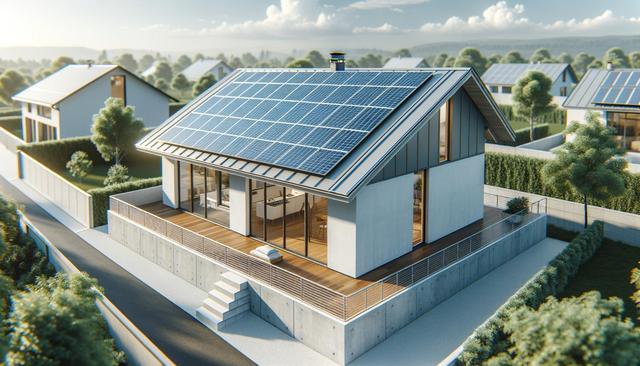Why Solar Roofs Are Gaining Popularity in the U.S.
In recent years, solar roofs have emerged as one of the most compelling advancements in residential energy technology. As more homeowners seek cleaner energy sources and long-term savings, solar roof systems offer a practical and visually appealing solution. Unlike traditional solar panels that are mounted on top of existing shingles or tiles, solar roofs integrate directly into the structure of a home. This design innovation has led to a surge in interest across the United States, particularly among homeowners who value both sustainability and aesthetics. By merging energy production with architectural design, solar roofs are helping reshape the way people think about renewable energy at home.
One important factor fueling the rise of solar roofs is the growing awareness of environmental responsibility. With climate change and carbon emissions being major concerns, individuals are looking for ways to reduce their ecological footprint. Solar roofs provide a clean, renewable source of energy that can significantly decrease reliance on fossil fuels. Moreover, because they generate electricity on-site, these systems help reduce transmission losses typically associated with centralized power grids. This appeals to homeowners looking to make a positive environmental impact while enjoying the benefits of energy independence.
Design Meets Functionality: A Seamless Look
One of the most appealing aspects of solar roofing is its ability to blend in with the home’s overall appearance. Traditional solar panels often stand out and can clash with a home’s design. In contrast, solar roofs are engineered to look like standard roofing materials such as shingles, tiles, or slates, depending on the model. This seamless integration means that homeowners no longer need to choose between functionality and aesthetics.
Here are a few design features that make solar roofs attractive:
- Low-profile installation that aligns with the roofline
- Durable materials that mimic conventional roofing textures
- Color and finish options to match architectural styles
These elements not only preserve but often enhance the curb appeal of a property. For homeowners in neighborhoods that prioritize visual uniformity or have strict homeowners’ association guidelines, a solar roof offers a discreet and compliant alternative to bulky solar panels.
Understanding the Technology Behind Solar Roofs
At the core of solar roof systems lies photovoltaic (PV) technology, which converts sunlight directly into electricity. Each solar tile or shingle contains embedded PV cells that capture solar energy and convert it into direct current (DC) electricity. This electricity is then routed through an inverter, which changes it into alternating current (AC) usable by household appliances and devices.
Several components work together to ensure optimal performance:
- Solar tiles or shingles with integrated PV cells
- Inverters that convert DC to AC power
- Energy monitoring systems for real-time performance tracking
- Optional battery storage for storing excess energy
These elements are designed not only for efficiency but also for durability. Solar roofs are built to withstand harsh weather conditions, including high winds, heavy rain, and snow, making them a reliable investment for a variety of climates across the country.
Financial Considerations and Long-Term Value
Installing a solar roof involves an initial investment, but the long-term financial benefits can be substantial. For many homeowners, the decision to adopt solar roofing is driven by the potential for lower utility bills and increased energy independence. Over time, the electricity generated by the roof can significantly offset or even eliminate monthly energy costs. Additionally, some states offer incentives, rebates, or tax credits that help reduce the upfront cost of installation.
Here are a few financial advantages of solar roofs:
- Reduction in monthly electricity bills
- Potential eligibility for federal and state tax incentives
- Increased home resale value due to energy efficiency
- Low maintenance costs compared to traditional roofing materials
It’s also worth noting that solar roofs are often accompanied by warranties that cover both power output and roofing performance, providing peace of mind for homeowners looking to make a long-term commitment to renewable energy.
Is a Solar Roof Right for Your Home?
While the benefits are numerous, a solar roof may not be the right solution for every home. Factors such as roof orientation, shading from nearby structures or trees, and local weather conditions can affect the efficiency of solar energy collection. Additionally, the age and structural condition of a roof may influence the feasibility of installation.
Before making a decision, it’s advisable to consult with a qualified solar energy professional. They can assess your home’s solar potential and provide a detailed estimate tailored to your needs. Homeowners should also consider their long-term plans—those intending to stay in their homes for many years are more likely to see a full return on their investment.
Some key questions to ask before installation include:
- Is my roof structurally suitable for solar integration?
- What is the average solar exposure of my property?
- Are there local or state incentives available?
- What are my energy consumption patterns?
Answering these questions can help determine whether a solar roof is a practical and beneficial choice for your unique situation.
Conclusion: A Smart Energy Choice for the Future
Solar roofs represent a meaningful step forward in sustainable living and home energy management. For American homeowners seeking to reduce their carbon footprint, lower utility costs, and maintain the aesthetic appeal of their homes, this innovative solution offers a compelling path forward. While the decision to install a solar roof requires thoughtful consideration, the long-term environmental and financial benefits make it an option worth exploring. With their blend of functionality, design, and performance, solar roofs are steadily shaping the future of residential energy solutions in the United States.




Leave a Reply